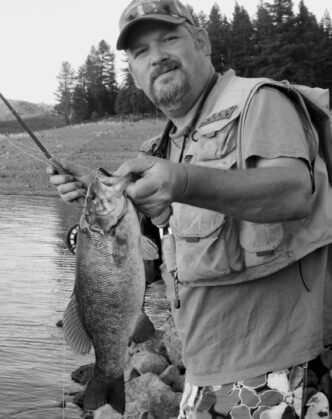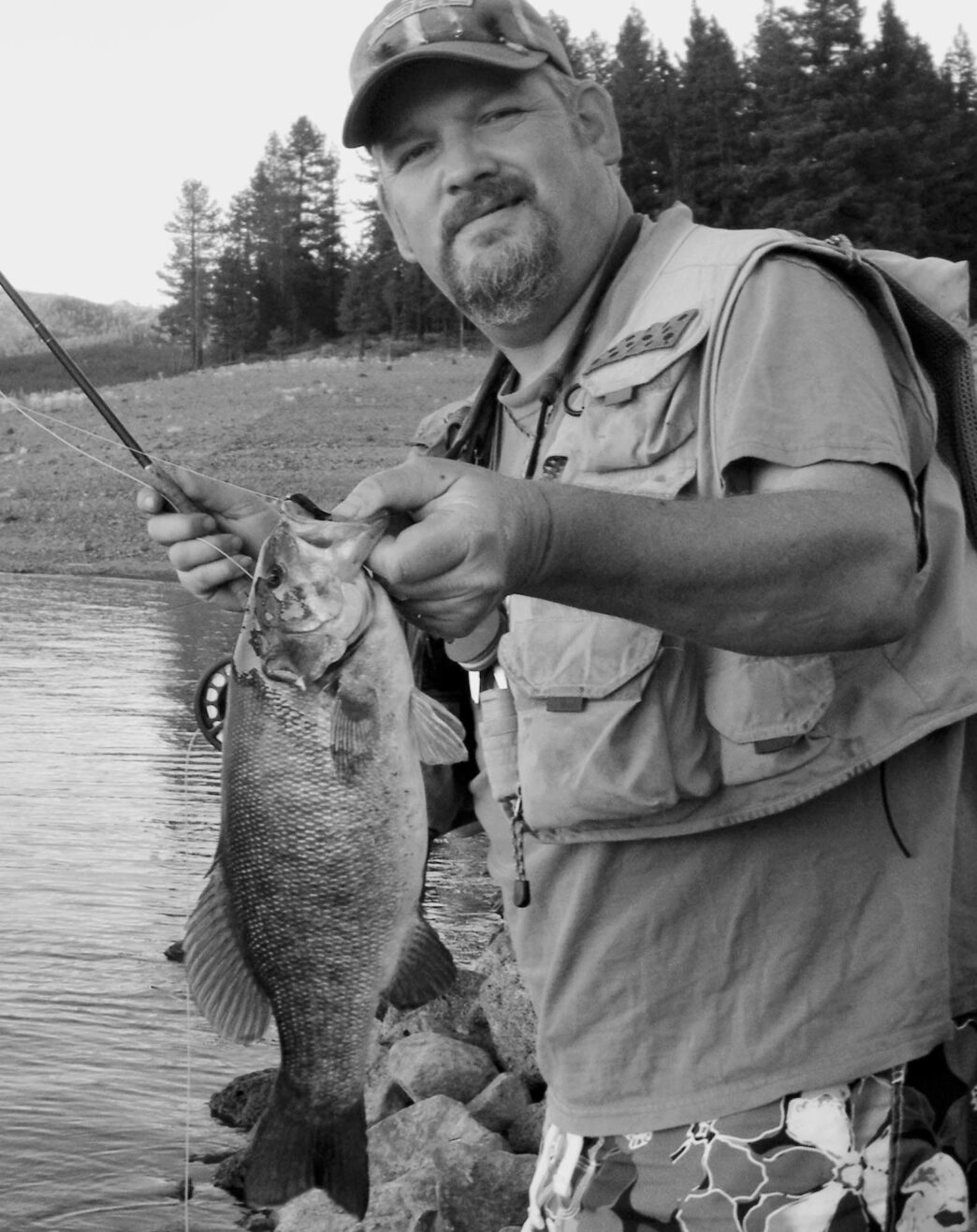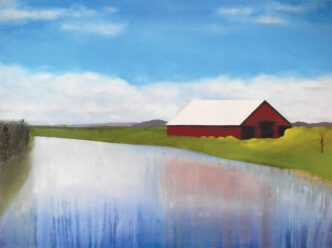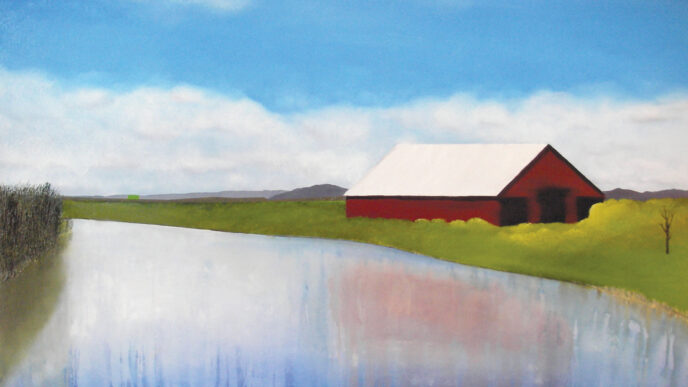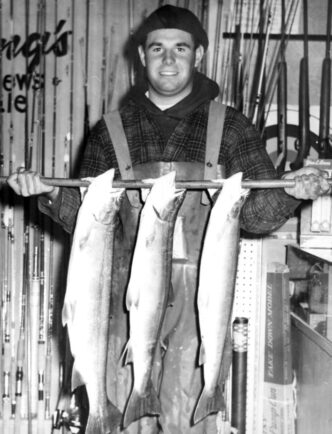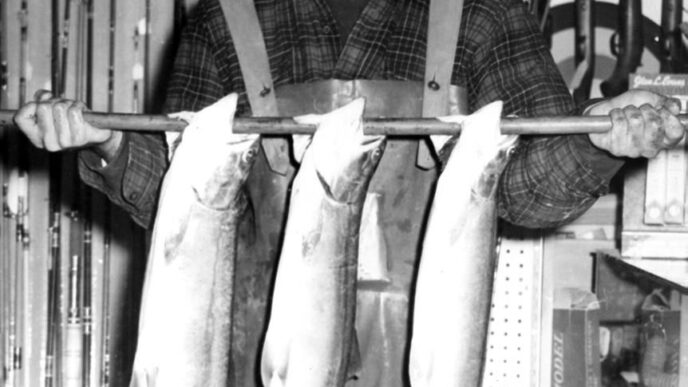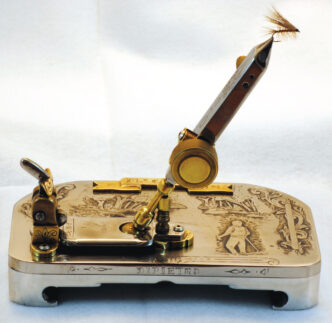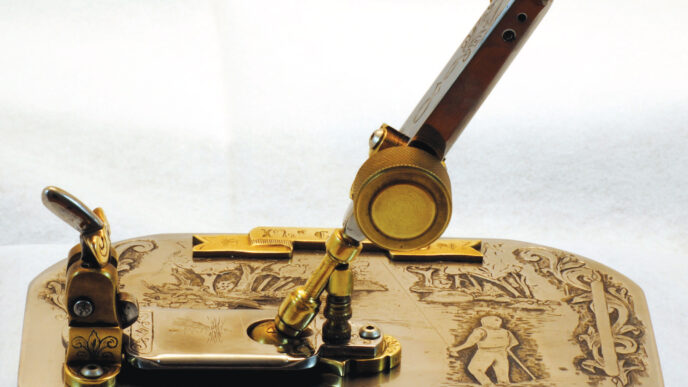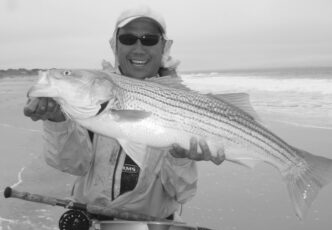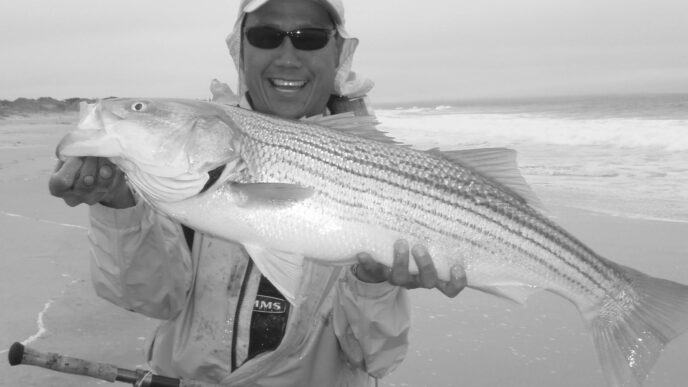How do you introduce someone who should need no introduction? Former California Fly Fisher “At the Vise” columnist and feature writer Andy Burk has promoted fly fishing both in the Golden State and beyond in myriad ways — as a noted fly designer and tyer, as a genial presence behind the counters of The Fly Shop in Redding and the Reno Fly shop, as a teacher of angling and tying techniques, both as a guide and on DVD and in cyberspace, and, well, just by being Andy Burk. This multifaceted angler has been and remains one of the select few who constitute the public face of fly fishing in California.
Bud: You were a fixture on the pages of California Fly Fisher, with both the “At the Vise” column and frequent feature articles, for a long time. What was it like at the beginning, and what are you up to now, since moving on?
Andy: It was really a great experience for me to jump from nobody to fly-tying columnist in the hippest angling mag around, writing about the things I love the most. Writing about fly tying and fly fishing helped me to grow as an angler, tyer, and most importantly, as a writer. This all happened despite my Hunter S. Thompson–style approach to deadlines.
I used to write in a frenzy of keyboard pounding and gallons of coffee. Toward the end of writing the regular “At the Vise” column, I remember thinking a couple of things. First and foremost was how long I’d done it and how damned hard it was getting to write that introductory paragraph. I knew it was time to step back when, after several stuttering attempts, I had gotten that paragraph done. As is my habit, I read it through, and I felt an eerie twinge of déjà vu. I went through my stack of back issues, and after reading a few of my introductions to past columns, I found an almost word-for-word version of that same introduction that I had written several years earlier.
At the same time, I was getting tired of being behind the counter at a fly shop more than I was on the water. So I quit the shop, I quit writing, and I departed for the desert. No, I didn’t get lost at Burning Man — I drove by Burning Man and into the rugged mountain ranges of northern Nevada in search of fire opals. I spent a year swinging sledgehammers and rock picks, prospecting for opals, and I found a lot of opals, in addition to other cool mineral specimens. But most of all, I found some inner peace and recharged my mental battery.
The solitude and beauty of the desert, the total thrill of extracting a large opal, the lack of cell phone service, no Internet, no TV, and very few people began to appeal to me immensely. After my first week in the desert, I knew that this was the place I needed to be. At one point, I went almost an entire month without talking to another human being — not that I didn’t want to, but there just wasn’t anybody coming to the places I was at. Not many folks would want to hike to the very top of that outcrop where I was to say “Hi.”
When I came out of the desert, I was filled with new ideas and fly designs, because I had sketch pads and notebooks with me and spent a lot of quiet time drawing and scribbling fishing notes. I returned to Truckee and started a little fly shop/art gallery of my own at my friends Doc and Cheryl Acevedo’s United Trails RV Park, Gas Station, and General Store and Deli. It’s a return to my earliest years in the flyfishing world, sampling bugs, fishing almost every day, and tying new flies to match all the cool little critters I find.
Bud: Even as a very young kid, to judge from the pictures I’ve seen, you seem always to have had some kind of fishing rod in your hand. When did you start fishing, and when did you start fly fishing? Did growing up in Susanville have anything to do with it — and with the career you’ve had since?
Andy: My parents got me into the outdoors early. There are many pictures in the Burk family archive that show me in my crib at Hat Creek, Eagle Lake, and other cool places. It was only natural that once I was freed from the confines of the playpen, a fishing rod would be thrust into my hands. I grabbed that rod and headed for the river, lake, or stream.
My parents always made time or concessions to feed my need to fish. During the summers of my high school years, I fished every day, walking to the Susan River early in the day and returning after dark. There was always a plate of hot food waiting for me when I came home.
I took up fly fishing and tying at 12, and it just took over. It was only a short matter of time before I was able to work my way into the rotation at the Sportsman store, located on the north end of the main drag in Susanville. The Sportsman was a treasure trove of angling lore, gear, and the normal sporting goods store high level of BS.
Jack Roberts, the old guy who owned the store, had opened it shortly after returning from a stint as a bomber pilot in the European theater during World War II. The stories I have from those early days at the Sportsman would fill a book! I worked as the shop fly tyer and as a clerk in the store until Jack decided to close the shop and retire when I was entering my senior year of high school.
Bud: You’ve worn many hats in the flyfishing business, and while most people probably know you as a fly tyer and designer, fly-shop resource, and author, I’ve heard it said that you were simply phenomenal as a fly-fishing guide and have guided all sorts of people, from the famous to the ignominious. Are there any war stories that you’d particularly like to recall?
Andy: I guided for a long time, and more than any other part of my career, it forced me to become a better angler. I started guiding right out of high school, for Bob Brinks at the long-gone Spring Creek Anglers shop in Burney. This was an immediate immersion into a world of taking different people fishing every day and having one goal in mind: Take people to places where fish are and show them how to catch them. I was a relatively shy smalltown kid, and I was suddenly exposed to all sorts of people and all types of personalities. As I got better, I got busier and busier, and my client list grew. Soon I was guiding as much as I wanted to. Over the years, I continued to guide until I finally reached a point where I realized that I was spending far more time on the water taking people fishing than I was doing my own fishing. I knew there was only one way to change that equation in my favor — quit guiding. So I did. I get regularly harassed by old clients, friends, and even a few guides telling me I need to be a guide. For now, I’m still out of the guide game.
War stories? Oh I’ve got plenty, I’ll tell you one on me. It was my first guide trip. My guide vehicle at the time was a 1963 Ford Falcon pickup, which, though gutless, provided me access to the storied waters I was near. My first client was an older gentleman named Gerth Hendrickson from Michigan. I loaded him into my primer-gray Falcon and headed for the Hat Creek Powerhouse 2 riffle.
About a mile and a half from the shop, Mr. Hendrickson informed me that he had forgotten his reel in his car at the shop. “No problem,” I said and whipped my car onto a dirt side road to turn it around. Unfortunately, my young driving skills and poor backing abilities caused a minor problem. In my eagerness to turn around and head back to the shop to get that reel, I somehow managed to rip the muffler and a good portion of the tailpipe off my car. I looked in the rearview mirror and saw the muffler and tailpipe assembly lying in the red dust. “Just a sec,” I said and hopped out of the car to retrieve my muffler. I picked it up and realized just how hot a muffler gets. I managed to burn the palms and fingers of both hands. Ever try to tie a size 18 dry to 6X with blistered fingers? It’s not much fun, I assure you. Mr. Hendrickson did catch two smallish rainbows and gave me my first tip. Sixty bucks! Of course, he did mention that it would probably be a good idea to use the tip to get my muffler fixed.
Bud: You’ve seen the ups and downs and more ups and downs of the fly-fishing business over quite a span of time — all the time wearing all those hats. What has changed and what hasn’t in the fly-fishing retail business?
Andy: The fly-fishing industry is like one big rollercoaster. Ups and downs are a normal deal. At this point, it seems to have all blurred together, because the products and personalities both change constantly and stay the same. After “The Movie” (A River Runs Through It), there was a sudden surge of new folks into the fly-fishing world. I was working at the Fly Shop in Redding at the time, and I, along with the other eight or nine guys who worked there back then, answered hundreds of calls and filled hundreds of orders. Complete outfits, from waders and boots to rods and reels and every other piece of fly-fishing miscellanea, were shipped out in quantity. This boom lasted for several years, and with the boom, the industry as a whole seemed to get a lot more competitive and more aggressive, with new product designs rolling out in mass quantities. Many great advances were made in the industry during this period, but at the same time, it seemed like there was a lot of stuff coming out that was just designed to remove money from expectant anglers’ wallets. Look at a catalog from one of the major fly shops at the time, and you will see many products and companies that no longer exist. In today’s challenging economy, the industry is once again changing. Only time will tell what steps the fly fishing world will take next.
Bud: Even before you departed the deadtree medium that is California Fly Fisher, you seem to have embraced quite enthusiastically what, as a print guy, I’ll call the “new media,” with YouTube video demonstrations, your own DVD — Andy Burk’s World of Fly Tying, Vol. One — and appearances on other people’s DVDs, such as Mikey Weir’s Soulfish. Plus, there’s your Web site and blog (http://www.andyburk.com). What do you see in such media that print doesn’t offer you?
Andy: My entry into the website and YouTube world was mostly facilitated by my friends and business partners Adam and Josh Bigelsen. Josh and I have fished together for years, and he continually bugged me about letting his brother do some filming of me tying and fishing. What I didn’t realize when Josh was bugging me about this was the amount of talent Adam has in the technology world. When Adam and I began filming and working together on a regular basis, I quickly realized that he was perfect for the job. Suddenly, all I had to do was create — no worries about how to get a rough video to a finished, soundtracked, YouTube presentation. I just sat down, tied the flies for the cameras, and Adam did all the rest. My Web site, blog, and any other cyberpresence I have are due to Adam’s hard work behind the scenes. I just do all the fun stuff.
Heck, my computer’s 10 years old, I’m not on the Internet, and I despised carrying a cell phone so much that when I dropped it in the water trying to snap a picture of a pretty little brown I had caught, all I could think was “Good riddance.” However, I am still a fan of the dead-tree medium, as I can’t lie in bed with my computer and read myself to sleep. Besides, when I do fall asleep and my book falls off the bed, it still works the next night.
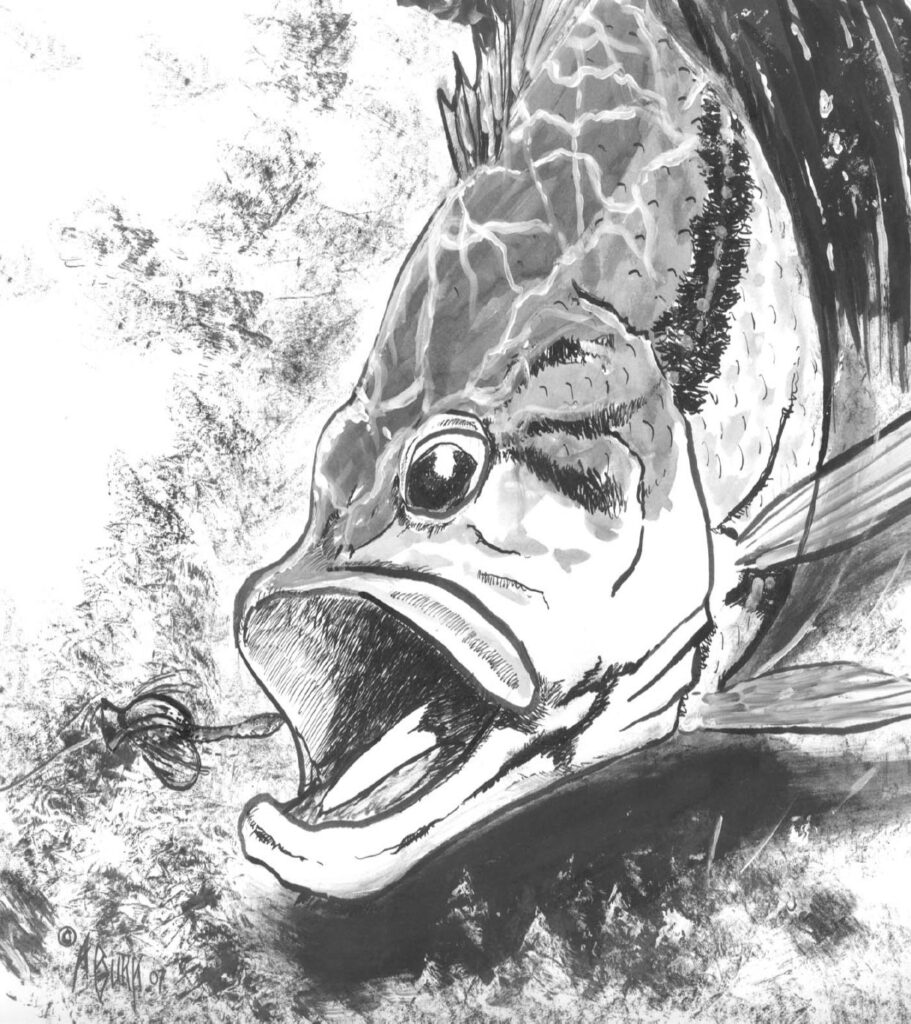
Bud: While we’re talking about media, lets talk about your artwork. I recall some early cartoons, then some tentative paintings, but lately, you seem to be doing a lot of that kind of work — and a lot of good work. How long have you hid a graphic artist under all those fly-fishing hats, and what kind of role do you see for art in your future?
Andy: I’ve been drawing and painting almost as far back as I remember. Before the world of fly fishing got me, I had a great desire to be a comic book artist. I just was not good enough at it. Also, I knew that moving to New York, working for Marvel Comics, and living in the big city would cut into my fishing time severely. It would be hard to fish when I had to get out the latest issue of The Avengers or The X-Men. However, all those comic books I read then and many of the comics I read now provide inspiration and ideas that somehow end up working their way into my weird little fly-fishing world. I always like to tell people that there are plenty of great artists who paint the serene beauty of our sport. I paint and draw the weird, twisted side of fly fishing. In the past couple of years, I have slowly returned to my comic book roots and have even created some work that I plan to publish as soon as I put together my EC/Underground style comic book of fishing horror stories. In the future, I plan to devote as much time as possible creating art and other objects. Art provides me a meditative medium that allows my mind to roam through all kinds of stuff as I swirl together little globs of acrylic paint on a canvas.
In my perfect world, I’d love to take some of my art heroes fishing. I imagine a day on the river with Frank Frazetta, Berni Wrightson, Robert Williams, Richard Corben, and Jack “King” Kirby. Just the thought of a Jack Kirby–penciled page filled with incredible fishing-related machinery would be ultracool. Besides, all of the big words I know I learned from reading comics!
Bud: You’re also something of a collector of collections. What started you collecting significant fly-fishing memorabilia? And what’s with the rock collection? When and how did you turn into a rock hound?
Andy: The collecting bug bit me early through comic books, and it was only when I began working at the Sportsman that I realized that there is a whole world of cool collectibles in fishing, as well. Once, opening a box in the back room of the Sportsman, I came across a complete set of the first 10 years of Fly Fisherman magazine, starting with the first issue. I lugged the box to the front of the store, hoping that Jack would allow me to borrow a few issues at a time so I could read more about the thing that had taken hold of my life. Jack looked in the box and said, “Ya got two choices, kid: Throw ’em in the dumpster or take ’em home.”
Of course I took ’em home. That began a long accumulation of Stuff, and I’m assuming that most readers know the late, great George Carlin’s rant about Stuff. I can’t help it — I like cool old things, things that were made by hand with a great deal of love and attention. Flies, art, books — I love it all. Although admittedly I’m not nearly as avid a collector of flyfishing memorabilia as I used to be, I still come across a few things each year that I must have.
The rock collection began somewhat by accident one day while I was walking my faithful fishing dog, Rosie. Walking the edge of a creek, I looked down in the shallows and saw what looked to be a piece of pink glass about the size of my fist. Picking it up, I realized that it was a large agate that had somehow found its way into this tiny stream. As I looked at that agate that evening, admiring its beauty, I began to think that if I got up a little earlier, I could take the dog on a walk in the morning and see if there were any other pretty pink agates lying around.
That next morning, I realized that the creek I had walked the dog along hundreds of times runs right through a serious field of agates and other semiprecious gems. I soon got a book on rocks and minerals, and it was a done deal. I discovered a whole new world of cool and reaaally old stuff. What’s cooler — a hundred-year-old fly, or a perfectly formed quartz crystal that’s millions of years old? I still can’t decide, so I make room for both.
And once I carefully extracted my first fire opal from a basalt outcrop located high in Nevada’s Calico Mountains, I knew that I had found a new calling. It’s actually very much like fishing. Searching for the perfect seam of agate or nodule of fire opal is very similar to reading a river and finding that big fish hidden away in a small, unlikely pocket. Rock hounding and fishing both offer the thrill of the hunt and the joy of finding or catching the big one. I like big, pretty mineral specimens as much as I like big, pretty trout and other game fish.
In addition, there are many great gem-collecting areas that are within close proximity to waters that hold fly-fishing opportunities. The major difference is that when you finally get that big trout in the net, you might be the first person to ever catch it, but realistically, you know it most likely has been caught before. When you break into a pocket of crystals hidden in a outcrop, you are the first person ever to see them, and they are millions of years old. It gives you a strange surge of adrenaline that is indescribable. And just as in fishing, I’m always after the big one.
Bud: Of all the hats you’ve worn, the one with your own fly patterns stuck in the band is probably the one most people recognize. Some fly tyers and designers are known for one kind of fly or another, but your flies cover a whole range of styles and applications in a number of dimensions, from spring creeks to salt water, from simple and suggestive (the Hunchback Infrequens) to detailed and realistic (a Callibaetis nymph I saw you tie at the San Mateo show one year), and from old school wets and dries to patterns invented to take advantage of the latest synthetic materials on the market or just to provoke a strike (the Aggravator). So unlike some tyers, you don’t seem to have a “signature fly.” If you had to pick one, though, what would it be, and why?
Andy: I’ll narrow it to the two that you mention, because of all the flies I have created, the Hunchback Infrequens and the Aggravator are my two favorites. Both flies literally fell together and worked great right out of the vise. Most of the time, there are many different variations before I finally hit on the ultimate version of a fly. I have a whole coffee can filled with failures and rejects or flies that worked, but didn’t work well enough. The true fun for me is just toying around at the bench, messing with materials and methods endlessly. The world of fly tying is so broad that I’m always finding new surprises and ideas.
Bud: In light of the breadth and depth of the collection of fly designs that you’ve produced, is there an underlying approach or design philosophy that characterizes how you go about developing a new pattern? How do you eliminate bad ideas and improve good ones?
Andy: My design philosophy almost always begins with not having the right fly for a certain situation that I come across. Necessity is almost always the mother of my fly-tying inventions. But then there is always room for improvement. I regularly change or update my designs, because I can never seem to quit tweaking a fly here or there. Sometimes it works, and sometimes it ends up in the coffee can with all its rejected or discarded kin.
It’s worth noting that I can think of plenty of instances in which I came up with the better mousetrap fly, only eventually to change it back to the original, because the new, improved version didn’t really work any better.
Sometimes idle time at the bench fooling around with materials creates an entirely new fly design. I encourage people to spend a little time bending, tweaking, and pulling on materials to see their limits and possible new uses for old materials.
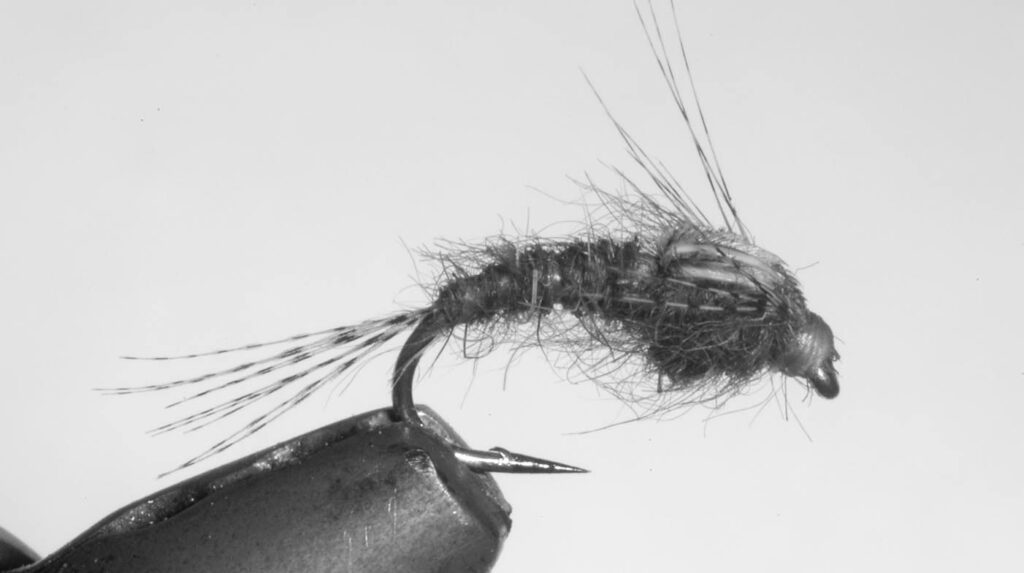
As tied by Amy McMahon of Temecula, CA
Bud: Tying flies, like playing a musical instrument, involves a series of manual techniques. In tying, how much of that can be taught, and how much depends on the talents brought to the job by the student?
Andy: Manual dexterity is the fly tyer’s greatest ally. I think few people are born with a natural ability to handle all the weird little grips, tweaks, and procedures involved in fly tying. The best way to develop great fly-tying hands is to tie a lot and never give up on learning new methods. Your comparison of tying flies and playing a musical instrument is worth noting: Many of the tyers that I hang out and fish with are guitar players, and it’s amazing how quickly guitar-playing fingers can become fly-tying fingers. The same probably applies to folks who play woodwinds and other instruments with complicated fingering. However, I am a frustrated guitar player. I tried really hard for a long time, and even though I can easily tie a size 22 parachute pattern, I could never master a single Iron Maiden solo!
But to become a better tyer, work on developing full hand dexterity — that is, you should be able to grasp materials as easily with your third finger and pinky as you do with your thumb and index finger. If you’ve got two thumbs and eight fingers, you should really train yourself to use all of them — in concert, as it were.
Bud: I know from editing your work for this magazine that although you don’t make a big deal out of it, you’re a really good entomologist and observer of the natural world. How can anglers cultivate that kind of attention and knowledge and apply it to their angling?
Andy: Observation of the natural world is truly the key to angling success. It’s easy to get a case of what I call “fishhead,” in which your only concern is catching a fish or catching that next fish. When all concentration is focused there, you may be missing the subtle clues of nature that would lead you to a really successful day.
Birds are one of nature’s greatest clues to what is really going on. Watch the birds on your local waters, and you’ll see many intriguing things. Swallows, for instance, are always a good indicator of hatch activity. When they are flitting about low to the stream, you know that there are insects present, and if the birds are eating them, the fish will be, too. Also, when you seen birds such as grebes, loons, and mergansers diving and feeding, you know that baitfish are in the area, and if there are little fish there, you can bet that the birds won’t be the only critters feeding on them.
And birds can teach you how to fish. The blue heron is one of my all-time favorite birds for one reason: Its embodies patience. I challenge you to spend an hour or two watching a blue heron hunt for its prey in the shallows. Look at the care with which it wades through the shallows and its utter and unshakeable stare into the water as it waits for the right moment to unleash and strike. Fish like a heron, and you’ll start catching bigger fish.
Become a student of the environments that you enter to fish. Spend an hour or two watching the stream, instead of charging up and down the bank, and you’ll find that over time, you will develop the skill set of a real predator.
It’s fun to know about the bugs, right down to their Latin names and such, and if you’re into the sport, you’ll eventually develop some bugspeak and bug identification skills. There are so many good bug books for the angler now that there is simply no excuse not to know a bit about the bugs on which our quarry regularly preys. You don’t need to know every little detail or even the Latin names, but once you start studying the bugs that fish feed on, it becomes a fun part of the angling day to turn over rocks and check out streamside spiderwebs for signs of bug life. Every day that you spend on the water can be a huge learning experience, if only you take a little time out from casting your line and instead fish with your eyes.
Bud: Lately, you have become a major proponent of the Czech nymphing approach, with flies and leaders marketed to fill that specific niche. What do you see in the technique, and what do you say to the inevitable critics who claim “That’s not really fly fishing”?
Andy: Czech nymphing was an eye-opening experience for me, and once I started learning the method, I quickly became addicted to the short-line approach, with its direct contact with the fish. I spent several years fishing the Czech method extensively, and I learned a lot about water dynamics and how to get flies to the bottom in the quickest, most efficient way possible. I also caught lots and lots of fish doing it. I still pull the Czech rigs out on a regular basis. They’ve earned a spot forever in my angling quiver. I rarely use the three-fly rig anymore, though, because as my skills with the method improved, I found I could get just as deep with two flies.
As for anyone who would say “That’s not fly fishing,” personally, while I think that every angler has to make up his or her own mind about the method, I don’t have much time for anglers who decide that this method or that method is not fly fishing. I don’t like fishing egg patterns or San Juan Worms, but I don’t care if you do, and I think that they both fit into our neat little match-the-hatch profile. I’ve even cast Rapalas on fly rods in the past, I wouldn’t call that fly fishing, but I still had fun, and that was my main goal. The Czech method certainly fits neatly into the parameters of fly fishing as I see it.
The only thing that I will rant and rail against until my last days is the peggedbead rig that has become so popular on many rivers in California and other states. That is not fly fishing. For me, fly fishing revolves around a fly that’s hand-tied on a hook shank. Since the hook was invented, it has been our task as anglers to make a fish ignore the hook and to take the imitation anyway. It’s our job to present the fly in such a way that the hook does not matter to the fish. If your fly or lure (and that’s what a glass bead is) is placed inches above a bare hook, the correct term to use for that approach to catching fish is “snagging.”
Bud: Here we are at the traditional Silly Tree Question. If you were a tree, what kind of a tree would you be?
Andy: Oh, have I ever been waiting for this one!!!!! If I were a tree, I would be a fly grabbing willow — or a whole stand of them — that ever so gently bent toward the water’s surface, shading the choicest of big fish lies. Even as a tree, I truly believe I would still desire a full fly box!



